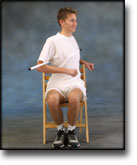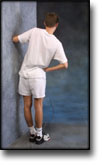| Instruction from the physiotherapist in correct back posture (ergonomic guidance) is important.
The indications of time after stretching, coordination training and strength training show the division of time for the respective type of training when training for a period of one hour. The time indications are therefore not a definition of the daily training needs, as the daily training is determined on an individual basis. |

Unlimited: Cycling. Swimming.

(15 min)
 |
|
 |
|
Lie on your back. Draw the injured leg up towards your head so that the muscles in the back of the thigh become increasingly stretched. Perform the exercise with outstretched as well as bent knee. Hold the position for 20 seconds and relax for 20 seconds before repeating. The exercise can also be performed standing with the injured leg outstretched on a chair while the upper body is bent slightly forwards.
|
|
Stand with support from the back of a chair or the wall. Using your hand, bend the knee and draw the foot up and your knee slightly backwards so that the muscles in the front of the thigh become increasingly stretched. Hold the position for 20 seconds and relax for 20 seconds before repeating.
|

|
|

|
 |
 |
Lie on your back with one leg outstretched and the other bent with the foot on the other side of the outstretched leg. Draw the knee up towards the opposite shoulder so that the buttocks become increasingly stretched. Hold the position for 20 seconds and relax for 20 seconds before repeating.
|
 |
Lie on your back with one leg over the other, and hold behind the lower leg’s knee. Draw the leg up towards your head so that the buttock on the upper leg becomes increasingly stretched. Hold the position for 20 seconds and relax for 20 seconds before repeating.
|
 |
Stand with your hands on your hips and slowly sway your back, pushing slightly with the hands to increase the sway, so that the stomach muscles become increasingly stretched. Hold the position for 20 seconds and relax for 20 seconds before repeating.
|
 |
Lie on your stomach. Rise up and support yourself on your elbows keeping your hip against the floor. Hold the position for 20 seconds. Rest for 20 seconds before repeating.
|

(5 min)
 |
Seesaw. Balance on two legs, possibly using a hand as support against the wall, balancing subsequently on one leg without support. Look straight ahead and keep knees bent.
|
 |
 |
Lie on the floor on a cushion. Bend your knees. Lift your hands from the floor and keep your balance.
|

(40 min)
 |
Sit on a chair with slightly curved back. Thrust your stomach forward and hold the sway-backed position.
|
 |
 |
Lie on your stomach across a table or chair and support with both arms on the floor. Raise one arm from the floor and hold the position for approx. 10 seconds. Change arm.
|
 |
Sit on a chair with a broom handle behind your back as shown in the sketch. Rotate from side to side at a steady pace.
|
 |
 |
 |
|
Lie on your back with knees bent and arms stretched out to your sides. Keeping your feet together, move your knees alternately right and left while looking in the opposite directions.
|
 |
Stand with your side against a wall. Support with your shoulder against the wall and press your hip in to the wall for 10 seconds. Rest for 10 seconds before repeating.
|
 |
 |
Lie on your stomach with both arms above your head. Lift your upper body.
|
|
|
|
Stretching is carried out in the following way: stretch the muscle group for 3-5 seconds. Relax for 3-5 seconds. The muscle group should subsequently be stretched for 20 seconds. The muscle is allowed to be tender, but must not hurt. Relax for 20 seconds, after which the procedure can be repeated. The time consumed for stretching, coordination and strength training can be altered depending on the training opportunities available and individual requirements.
|
|
